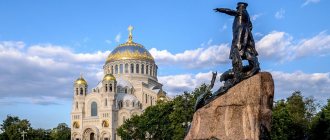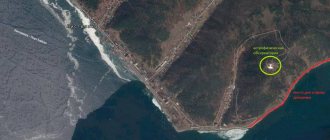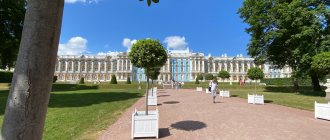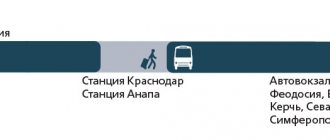City `s history
The island itself has been familiar to the residents of Novgorod since ancient times, but gained universal fame in 1703, when, by decree of Peter I, a fort was founded, designed to protect the new capital of the Russian Empire and its western borders. In 1723, the construction of the fortification was completed, and it was given the name Kronstadt, after which the city itself began to be called. The Emperor considered it part of St. Petersburg and paid special attention to the construction and development of the city. The most famous architects of that time were involved as developers: Trezzini, Bazhenov, Cameron, Chevakinsky.
Kronstadt confirmed the title of a defensive bastion in 1854, stopping the Anglo-French ships trying to approach St. Petersburg. Over the course of several decades, the bastion actively grew, was modernized with the latest military technology, and by the beginning of the 20th century there were 17 fortified islands. At the same time, Kronstadt became the country's largest port and an important shipbuilding hub.
During the Great Patriotic War, the fort was under siege. Kronstadt had no easier time than Leningrad. But even when surrounded by enemies, the ship repair base continued to operate in the city and ensured that submarines could go to sea.
Nowadays everyone can visit Kronstadt, but this was not always the case. The city was opened to the general public only in 1996, after the inclusion of key locations of the island on the UNESCO heritage list.
What to see in Kronstadt: 19 ideas for a 1-day trip
Ships, sailors, guns, turbines, a cathedral in the center of the city, more ships, more sailors and more guns... So, consider that we saw the whole of Kronstadt. It is worth coming here, first of all, for those who are interested in the history of the Russian Navy. Kronstadt is a fortified city, completely different from other suburbs of St. Petersburg. There are no palaces here, like in Peterhof or Strelna. Only huge metal ships bristling with cannons; a huge cathedral in the city center and half-forgotten forts scattered across numerous islands.
However, let's not get ahead of ourselves too much. Read about what to see in Kronstadt and how I saw this city in my new article from the “Russian cycle”. Imagine that this text is filled with the splash of waves, the sound of the wind and the metallic shine of military weapons. Introduced? Then let's begin...
How to get to Kronstadt from St. Petersburg?
Buses and minibuses go to Kotlin Island, where Kronstadt is located. From the Chernaya Rechka metro station you can get to the city by minibus No. 405. And from the Staraya Derevnya station there is bus 101.
The minibus costs more (89 RUB), but you can get to the city in 40 minutes. The bus travels one and a half times longer (1 hour), but it is more comfortable and costs less (50 RUB). I wrote in great detail about how to get to Kronstadt on your own in this review.
Well, here I still advise you to go to the island on an excursion. So, in one day you can walk around Kronstadt, take a boat ride around the military forts and learn many interesting details about the past and present of the city. In any case, your independent program will not be so intense.
A couple of excursion options that I personally like can be viewed in the windows below. Or you don’t have to look. We'll come back to them a little later.
What to see in Kronstadt in 1 day?
If you are too lazy to read the entire article, then write out this list for yourself, and then, while walking around the city, cross off the attractions one by one (like purchases when going to a store). So... During a trip to Kronstadt it is worth seeing...
- Naval Cathedral and monument to Admiral Makarov
- Obvodny Canal and former Admiralty buildings
- Petrovsky Park and the monument to Peter the Great
- Museum of military equipment "Patriot" , wooden lighthouse and Middle Harbor
- Italian Menshikov Palace
- Petrovsky dock
- Footstock and tide gauge
- Fort "Constantine" and other defensive bastions of Kronstadt
- Buildings of the former maritime school
- New park "Island of Forts"
- Vladimir Cathedral and some other locations.
I highlighted the most interesting things in dark colors. These places are worth seeing first. Everything else is just that... part-time attractions. To find them all, use the MAPS.ME mobile navigator. But it’s difficult to get confused there. Most of these places will come your way.
Minsk-St. Petersburg: 5 best ways to get from one city to another
Walk around the city
And now about everything in a little more detail.
The bus from St. Petersburg arrives at Grazhdanskaya Street in Kronstadt, so your route will most likely start from this place.
Just around the corner, 200 meters away, there will be St. Vladimir's Cathedral. This is not the main attraction, but since it is not far away you can take a look at it.
Next, walk up Lenin Street. If you have a lot of time, you can take a short walk here (this is one of the main thoroughfares of the city). If you’re pressed for time, then go straight to the Naval Cathedral.
I chose the second option - and very soon I found myself in the park near the Obvodny Canal and the Admiralty buildings. I read somewhere that they are similar to the St. Petersburg island “New Holland”. But it is not so. In reality, they are scary, like the movie “Saw 4”. Imagine a greenish river encased in darkened concrete; brick buildings that look like broken teeth in the mouth of a homeless person... I, of course, tried to photograph the canal more or less beautifully...
But in reality, most of its buildings look something like this.
The main advantage of the Obvodny Canal is that it is relatively small. You see him, shudder, but after a couple of minutes he remains somewhere behind. The dome of the Naval Cathedral appears above the treetops. Next to it are stalls with magnets and souvenir vests. And one of the ugliest places in Kronstadt is replaced by one of the most beautiful.
When you find yourself on the square, look for the monument to Admiral Makarov.
Directly behind it there will be a bridge that will first take you over the ravine and then lead you onto the road to Petrovsky Park. Overall, the park is just like a park. Nothing unusual. But right behind it there will be a harbor with many warships. As I said, it’s worth coming to Kronstadt precisely for such naval views.
In principle, you can look at all these cannons, turbines and lighthouses from the shore. But if 250 rubles (3€) is not money for you, go to the Patriot military park, which is located on the local pier. There are the same guns and ships, but you can look at them closer.
If you have other plans for that same 250 RUB, then move on to the Petrovsky Dock. Today it is a jumble of trailers, cranes and rusty pipes. Frankly speaking, this attraction is not for everyone. But it was once considered almost an engineering marvel, where 10 large ships could be repaired simultaneously. Therefore, now it is a constant guest in all tourist guides.
To the left of Petrovsky Dock is the Italian Palace. This is such a Mickey Rourke in the world of Kronstadt architecture. He was once handsome, but after a series of plastic surgeries he changed beyond recognition. This is how he used to be...
And this is what it looks like now.
I passed by it two or three times, but only after the fact I realized that this was the same palace built in 1724.
This is what the Italian Palace looks like from a different angle.
And right in front of it is another part-time attraction - the Kronstadt water pole, created to measure water levels in the Baltic Sea. Every time I passed by it, tourists crowded here in droves. Therefore, I repeat once again - it is better to go to Kronstadt with a tour. Let some guide tell you instead of me what this miracle thing is.
Forts and lighthouses of Kronstadt
About 300 meters from the Italian Palace there is a small park, next to which there is a local tourist information center. Address – Martynov street-1. There you can take a free map and talk to one nice girl about what attractions you haven’t visited yet.
Spoiler - she will most likely tell you about the former building of the maritime school, which is located on the opposite side of the island and looks quite sad...
And also about the various military forts that are scattered in the Gulf of Finland near the coast.
Getting to them is quite difficult. You can get to Fort Constantine by taxi for 100-200 RUB. But it’s better to explore all the other lighthouses and forts as part of a sea excursion.
To do this, you first need to walk 1.2 kilometers to a park called “Island of Forts”. It is positioned as a museum and historical complex, but now it is still just a beautiful park with a food court, playgrounds and, of course, an abundance of cannons. It was opened quite recently (the second part should only be presented on July 25, two days after the publication of this article). But it has already become an important place in the life of the city.
Park Island of Forts
So... Sea excursions in the direction of those very forts and lighthouses of Kronstadt start from here. It is better to book your seats in advance using this link.
The excursion time is 45 minutes.
The route passes along six forts and one lighthouse. But the program may change. The ship companies of Kronstadt do not consult with me. Therefore, it is better to read the details at the link that I gave above.
What to see in St. Petersburg in 1-2 days: TOP 20 places
The way back to St. Petersburg, and how to make it more interesting
If you listened to my advice and still went to Kronstadt on an excursion, then you can safely skip this paragraph. After Kotlin Island you will be loaded onto a bus and taken somewhere further (most likely to Peterhof). But if you still decide to go to Kronstadt on your own, then here’s one more piece of advice for you on your way.
When you return to St. Petersburg, get off at the Begovaya metro station. It is also passed by minibus 405 and bus 101. Next to it there will be a large shopping mall, and right behind it will be the park of the 300th anniversary of St. Petersburg. The total distance to walk there is 700 metro. And it’s worth going this way for at least three reasons.
First of all, there is a beach right behind the park. And secondly, it is from here that the most beautiful view of the Gazprom Arena and the Lakhta Center skyscraper opens. To be honest, I cannot call it an architectural masterpiece (although if they pay me, then, of course, I can). But it’s still worth looking at the tallest skyscraper in Europe, the construction of which cost an astronomical sum of 1.77 billion dollars (!). You will get a bonus for your trip to Kronstadt. Sort of like the icing on the cake (or whatever it looks like)? Leave your answers in the comments. And with these words I will say goodbye. Don't forget to follow my Instagram. And travel more often!
The main attractions of Kronstadt
Anchor Square
Located in the heart of the island, until the end of the 19th century there were warehouses with anchors and chains here; it is to this circumstance that the square owes its name. There is a monument to Admiral Makarov, who lost his life in battle during the Russo-Japanese War, and a mass grave for those killed during the revolution and civil war.
Naval Cathedral
The temple is dedicated to the memory of sailors who died for the honor and freedom of their homeland. This monumental building, created in the neo-Byzantine style, immediately attracts the attention of tourists. The large dome, decorated with anchors and sea piping, the interior decoration of the cathedral - everything speaks of the last refuge of sailors.
Forts
There are 19 of them in total. And the forts are located on artificial embankments of the Gulf of Finland. Each structure has unique architectural features and history. It is interesting that the forts were built gradually, and the initial buildings were built according to the experience of Dutch architects. Later, Russian engineers developed their own style of constructing embankments and strengthening the soil.
Petrovsky Park
It was founded in the 19th century by order of the governor of Kronstadt, who decided to create more green areas in the city and personally selected the territory and seedlings for the future park.
The central element of the park is the monument to Peter I, and it ends with the Winter Pier, from which you can enjoy the power and beauty of the Baltic Fleet. Also interesting to view are stone vases from the late 19th century and cannons from the ship "Emperor Paul I".
Museum of the History of Kronstadt
Historical exhibits from all over the world are presented here, a lot of information is collected about the construction of port facilities, documents about the founding of the city and the difficult years during the Second World War. The museum also houses several compositions dedicated to maritime and underwater affairs. Those interested can try on diving equipment and, feeling like real submariners, take a photo.
There is an interesting belief in Petrovsky Park. According to him, sailors, when setting sail, planted a young tree. If upon return the seedling pleased the eye with green foliage, it means that the beloved was faithfully waiting for the hero. If the plant did not take root, then, most likely, the girl gave her heart to someone else.
History of Kronstadt
Kronstadt was founded in the fall of 1703. An architectural monument of the 18th-19th centuries, it was the main base of the Baltic Fleet.
The Kronstadt fortress is a quadrangle. It was surrounded by towers and a steep slope.
The west was closed by an escarpment, which was eventually replaced by the walls of defensive barracks. A canal called the Kronverksky canal has been dug around. The north and south of the canal were covered by an auxiliary building with a gate, blocking access to the ditch of water and regulating its level at the required height.
On the northern side, defense structures were built in 1871 - 4 barracks, equipped with half-towers. In the east there was the 5th barracks for defense, called the Eastern barracks.
The entrance from the sea was protected by the Prince Menshikov battery and the protective structures on which the guns were located.
To the west of the crownwork there were lunettes - field fortifications.
The first fort on Kotlin Island was built in 1703. He defended the passage to the northern capital. It was built by the regiments of Colonels Tolbukhin and Ostrovsky in the winter, and was erected in six months. Engineer Kormchin supervised the work. A month passed and the Swedes tried to capture the island. They began to fire at the fort, but were unsuccessful. One year later, a Swedish squadron again tried to take the fort, but they left with huge losses. Vice Admiral K. Kruys said that it would be nice to make another fortress. In 1705 there were 5 batteries on the island. The fortress continued to be built. The plans of Peter I required both funds and people, who were forcibly moved here from the provinces. Some attempted to escape.
Construction of the Kronstadt fortress began 20 years after the construction of the forts. Peter I personally approved the development plan in 1721, and he also founded the fortress, which was called Kronstadt. The Kegorn system served as the basis for the construction of the fortress fence. The soil was brought from the mainland, where it was mined by hand. A wall, barracks and towers were built along the embankment, and 358 cannons were placed.
In order to facilitate the transportation of goods and cargo, canals were dug. In 1751, construction of the docks was completed. Their length was more than two kilometers. Later, a large steam engine was installed here, which pumped out water. Residential buildings were built on specially designated plots.
The iron foundry was built in 1789.
In 1771, the First Naval Cadet Corps was stationed in the city. The graduates were I. Kruzenshtern and Y. Lisyansky. They made a round-the-world expedition. F. Bellingshausen and M. Lazarev assembled an expedition and went out on ships in search of the southern continent. After 2 years, they returned to the city with news of the continent they had discovered - Antarctica.
During the Great Patriotic War, the city closed Leningrad from the fascist invaders. Frequent bombing and shelling severely destroyed Kronstadt, but work on repairing ships did not stop.
At the beginning of its history, the city was built of wood. It was planned to replace the wooden fences with stone ones in 1734. Work began, but 3 years later the Russian-Turkish War prevented the plan from being implemented. In October 1757, a hurricane swept through, causing extensive damage to the fortifications. They wanted to restore the city using stone, but after drawing up an estimate they were convinced that using wood would reduce the cost by 20 times. Only 25 years later Kronstadt was destined to become “stone”.
In 1784, by decree of Tsarina Catherine II, a special commission discussed the work plan of the Admiralty in the city of Kronstadt. The project developed by Admiral Greig determined the development of office buildings and residential premises. Stone construction, which also used the strength of prisoners, began. But the Kronstadt Fortress and Kronstadt were destroyed by the elements in 1824. The flood caused enormous damage: the island was covered with water.
In a short time, Count Sukhtelen proposed a project for restoring the fortifications. Work began and was completed in the summer of 1826. They were led by engineer Lvov. The new fortress was almost no different from the old one. Nowadays, the city is undergoing improvement. The Northern Wall, which runs along Vosstaniya Street and Zosimov Street, is in good condition.
Interesting Facts
- Kotlin Island did not always belong to Russia. It was in the possession of Sweden, but Peter I, understanding the importance of its location, did the impossible - in a few months he built a fort, through which not a single enemy ship could break through. The Swedes also failed to return Kotlin to their possessions. After making several attempts, they were forced to recognize the superiority of the Russian fleet and retreat.
- According to legend, while retreating from the fort, Swedish troops left a hot pot with delicious food, which was discovered by Peter I. Thus, the island got its name - Kotlin.
- More than 40 expeditions around the world were sent from Kronstadt and 56 large-scale geographical discoveries were made.
- In 1874, a major fire destroyed more than half of the city. This sad moment is depicted by Alexey Bogolyubov in a painting, which can be viewed at the Museum of Fine Arts of the Republic of Tatarstan or on their official website.
- On Anchor Square there is the only pavement in the world made of cast iron blocks. Unfortunately, only a small part of it has reached us.
What to buy and where to eat in Kronstadt
Among the establishments where you can eat inexpensively and deliciously, we recommend paying attention to the Kashtan restaurant, located on Lenina Avenue, 25, and the 24-hour express cafe “VLAVASHE” on Lenina, 13.
Souvenirs in the form of figurines, magnets, clothing with naval symbols, caps, flags, postcards, plates can be purchased in the appropriate shops on the main streets or near key attractions.
Museum opening hours and prices
- Naval Cathedral. Opening hours: daily, admission free. Located at: Yakornaya Square, 1.
- Museum of History. Opening hours: Monday - Sunday, except Wednesday. Ticket price: 150 rubles for adults, 75 rubles for schoolchildren and pensioners. Teens under 18 years of age receive free admission every third Tuesday of the month.
- Maritime Museum. Schedule: Wednesdays, Fridays and weekends – from 11:00 to 18:00. The entrance is free.
- Cathedral of the Vladimir Icon of the Mother of God. On weekends it is open every day from 9:00 to 20:00.
- Forts. You can explore the forts yourself at any time from the coastline or dam. It is not possible to get inside, since many of the buildings are in poor condition, and some serve as a springboard for military exercises of the Russian Army.
Excursions around Kronstadt
On the Sputnik website you will find 11 sightseeing tours of Kronstadt, including individual bus trips around the city, group programs, motorcycle rides, excursions to Kronstadt on a meteor, trips to forts and non-tourist attractions of the city on a longboat. The tour program includes:
- Viewing architectural and historical monuments: the Naval Cathedral, forts, the Admiralty, the footstock, the monument to Peter I, Petrovsky Dock and others.
- Sea travel on a motor ship.
- Guided walks in Petrovsky Park.
- Getting to know the history, traditions and legends of the island.
Historical and cultural complex “Fort Grand Duke Constantine”, Museum of the Lighthouse Service and “Pushkar”
It's no secret that Kronstadt is a city that is surrounded by forts from all sea approaches. Fort Constantine is one of the largest former artillery forts with preserved batteries, barracks, a rangefinder pavilion and other fortifications.
Nevskie News / Valeria Petrik
Nevskie News / Valeria Petrik
Nevskie News / Valeria Petrik
You can get to Fort Constantine by free bus. This year the number of stops will increase: the shuttle will pick up passengers at the “Kronstadt Highway 38” stop, a stop at the entrance to and exit from the city, as well as at the “Island of Forts” museum and historical park.
Nevskie News / Valeria Petrik
Nevskie News / Valeria Petrik
You can spend the whole day walking around the fort and enjoying the views of the Gulf of Finland. However, this is not the only entertainment. There are two amazing museums on the territory: the lighthouse service and the Pushkar museum.
Nevskie News / Valeria Petrik
Nevskie News / Valeria Petrik
The first one collected a unique collection of items related to lighthouse business: Fresnel lenses, lamps and all kinds of details of lighthouse technical equipment. The museum staff will tell you about the history of lighthouses: from Alexandria to the lighthouses of the Gulf of Finland.
Nevskie News / Valeria Petrik
Nevskie News / Valeria Petrik
The Pushkar Museum will open during the 2022 tourist season. Previously, this museum was not included in the city’s tourist map. The idea to create it belonged to a St. Petersburg collector and enthusiast who, during his professional life, collected a solid collection of artifacts telling about the life of Russian artillerymen - gunners.










